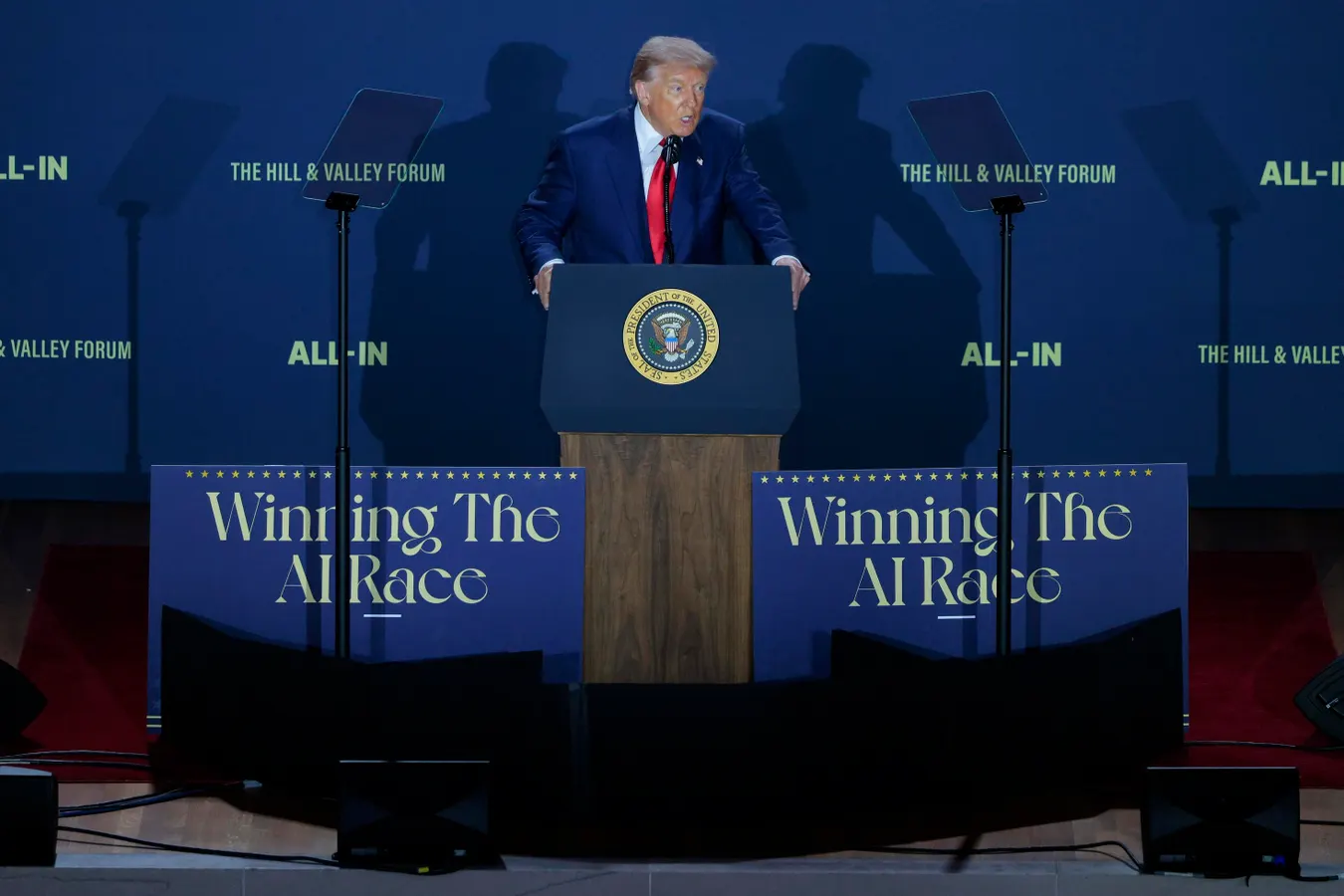By Alden Abbott,Chip Somodevilla,Contributor
Copyright forbes

WASHINGTON, DC – JULY 23: U.S. President Donald Trump speaks during the “Winning the AI Race” summit hosted by All‑In Podcast and Hill & Valley Forum at the Andrew W. Mellon Auditorium on July 23, 2025 in Washington, DC. Trump signed executive orders related to his Artificial Intelligence Action Plan during the event. (Photo by Chip Somodevilla/Getty Images)
Getty Images
A spate of major investments by large tech firms in U.S. artificial intelligence companies should be viewed as a sign of vibrant competition that drives innovation. Antitrust intervention to limit such investments would be inappropriate. A cautious approach to antitrust combined with deregulation could be the ticket ensuring continued American leadership in AI.
AI Firms: Major Investments and Dynamic Competition
As a 2025 Forbes analysis explains, “[a]rtificial intelligence companies (whether apps or model makers) typically rely on expensive silicon chips and energy-intensive data centers for computing power to train and run their models and applications.” That fact, coupled with the realization by businesses that AI offers an enormous potential for business productivity growth, has incentivized tech firms to invest heavily in AI enterprises.
Nvidia’s recently announced $100 billion investment in OpenAI is the latest in a series of tech-company alliances with AI firms. OpenAI, Oracle, and SoftBank very recently revealed 5 massive new AI infrastructure sites under Project Stargate, bringing their total planned capacity to 7 gigawatts and nearly $400 billion in investment. Other AI firms have obtained major third party investments as well – no single firm is becoming dominant in the AI sector.
Indeed, as Computer & Communications Industry Association Chief Economist Trevor Wagener recently explained, the AI sector is very competitive, characterized by intense rivalry across multiple layers, from hardware to applications. While tech giants dominate, the market features a rich ecosystem of challengers, including startups and open-source projects.
The AI ecosystem embodies intense rivalry, not monopoly:
MORE FOR YOU
The layered “AI stack”: The AI sector is not monolithic, but rather a series of interconnected technologies. Competition is fierce at every layer of this stack, including:
Hardware and computing infrastructure: Major players like Google, Amazon, Microsoft, and NVIDIA are aggressively developing specialized AI chips to enhance training and performance.
Foundation models: There is fierce competition among developers of large language models (LLMs) and other advanced models. The performance gap between leading models is rapidly shrinking, indicating a crowded and competitive frontier.
Applications and services: Many firms build specialized AI applications and tools for end-users. The diversity of players and business models at this layer creates a rich competitive mix.
Cloud Access: As described by Trevor Wagener of CCIA, “top-tier AI startups like Anthropic, Cohere, and Character.ai have struck deals with different cloud providers (some use AWS, others Google Cloud, etc.), ensuring that no single cloud company “locks up” all promising AI firms. In fact, cloud vendors often offer special incentives, optimized hardware, and dedicated AI services to attract AI developers onto their platforms, which indicates how fiercely they compete to be the go-to deployment venue.”
Massive investment: Private and government investment in AI is at an all-time high globally, fueling rapid innovation. In 2024, private investment in the U.S. and global investment in generative AI saw significant growth.
Decreasing costs and increased accessibility: Advancements in hardware efficiency and open-source models are lowering the barriers to entry for advanced AI. The inference cost for models performing at the level of GPT-3.5 dropped over 280-fold between late 2022 and late 2024, making advanced AI more accessible.
Rapid innovation cycles: Competition is driving a “virtuous cycle” of innovation where breakthroughs by one firm quickly become the baseline for others. The constant need to evolve prevents any single player from achieving lock-in dominance.
Wagoner sums it up:
“AI is proving to be a disruptive force within tech ecosystems, breaking open markets and spawning new entrants rather than entrenching incumbents. The evidence is clear that competition in AI applications is vibrant and delivering rapid innovation and expanding consumer choice.
In other words, far from threatening competition, AI alliances promote enhanced dynamic competition.
The Specter of Antitrust
Despite all these signs of effective competition, U.S. and foreign antitrust enforcers nevertheless have shown a strong interest in potentially challenging AI ecosystem arrangements.
Antitrust and technology expert Professor Jonathan Barnett of the University of Southern California describes the spate of aggressive investigations into AI markets (including those involving agreements between large technology platforms and smaller AI providers) by trust busters from the United States, the European Union, and multiple other nations.
As Barnett emphasizes, the focus of antitrust agencies on AI arrangements “reflects the ascendance of a preemptive approach toward antitrust enforcement in digital markets,” which favors early intervention in the fear that those markets are likely to “tip” in an anticompetitive direction. Scale economies and network effects of digital markets are thought to favor the eventual emergence of only one or a limited number of dominant firms in markets. (Antitrust proponents typically fail to note that scale economies and network effects reduce costs and increase value to the benefit of consumers.)
The competitive facts on the ground, however, lend no support to fears of imminent market dominance in the AI ecosystem. The precautionary instinct is at odds with the American economics-oriented, case-and-fact-specific antitrust enforcement philosophy, which, as Barnett puts it, justifies antitrust prosecutions only when “the enforcer can identify sufficient evidence to infer that a particular practice is actually or likely causing harm to competition.”
This careful approach avoids the costs of prosecuting benign conduct that, especially in digital markets and “AI space,” holds the prospects of showering enormous welfare benefits on society.
The threat of imminent litigation that interferes in business planning also may be expected to disincentivize AI innovation, to the great detriment of the American and global economies. The many alliances that are driving AI innovation forward could wither. Professor Barnett’s analysis finds that “preemptive intervention on antitrust grounds [in AI markets] appears to lack a reasonable justification and raises the risk of distorting and harming the market’s future trajectory.”
A recent analysis cited by CCIA estimates that “AI-related products and improvements will contribute $15.7 trillion to the global economy by 2030, including $3.7 trillion to the U.S. economy (14.5% of total estimated GDP).” But those benefits could be reduced significantly to the extent antitrust prosecutions deter welfare-enhancing investments and business arrangements affecting the AI ecosystem.
A Reasonable Path Forward
President Trump’s 3 July 2025 executive orders that accompany “America’s AI Action Plan” explicitly seek to promote American AI leadership by removing regulatory impediments to AI. This deregulatory approach is a central component of the administration’s AI strategy, following an earlier January 2025 executive order, “Removing Barriers to American Leadership in Artificial Intelligence.”
An overly interventionist antitrust approach to AI alliances would run counter to this important Administration priority. U.S. antitrust enforcers in the U.S. Department of Justice and Federal Trade Commission may wish to keep this in mind in developing their antitrust enforcement strategy affecting the AI ecosystem.
This would not be a “do nothing” strategy. It would involve monitoring of the AI ecosystem to spot any new practices that could seriously inhibit or otherwise distort competition (such as the creation of inefficient barriers to the entry of potential rivals, for example). It would require compelling evidence of likely or actual competitive harm before acting, rather than reliance on “fishing investigations” driven by purely theoretical concerns about the future.
Practices that are not well understood by enforcers should not be the target of preemptive antitrust action.
A substantial reduction in regulatory barriers, coupled with a cautious facts-based antitrust philosophy dedicated to doing no harm, make sense. This could be the best formula for promoting a dynamic world class American AI sector that enhances economic growth.
Editorial StandardsReprints & Permissions



